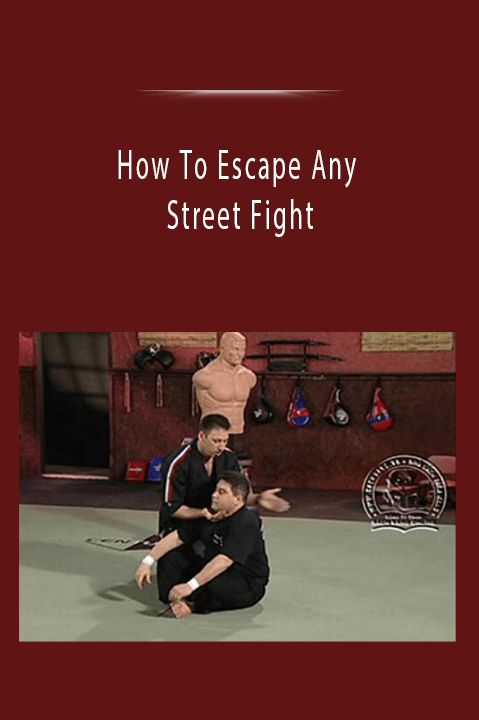How To Escape Any Street Fight
HOW TO WIN A STREET FIGHT
Learning “how to win street fight” with the skill and confidence of a seasoned fighter is something that can certainly be achieved. As a matter of fact, I’ve dedicated my entire live to teaching law abiding people how to defend and protect themselves in the streets.
However, I have to tell you from the start that it’s not such and easy task; it will require a bit of dedication on your part. But, if you are willing to do some serious studying as well as some practical self-defense training you could learn the skills necessary to win a street fight.
Before we begin, you must understand the information in this article is just a small fraction of what you need to know about winning a street fight. I strongly encourage you to take your research further and read the many books featured on this website. Having said that, lets talk about street fighting and what it takes to win.
STREET FIGHTING IS NOT MMA
First off, let me clarify that learning how to street fight is not the same as studying mixed martial arts or a practicing a formal style of traditional martial arts. Street fighting is an animal with proteon behavior that often has deadly consequences for the participants.
The truth is, a street fight also has many different faces and takes on many different forms. One minute it can be a fist fight in a trendy yuppie bar while the the next could be a deadly knife fight in a godforsaken part of town. As the saying goes, no two street fights are ever the same! So your training will have to be “alive” and combat diversified!
In many of my street fighting videos, I have defined a street fight as a spontaneous and violent confrontation between two or more individuals where no rules will apply. A real street fight is not about the boxing ring, rules and regulations or any combat sports competition. It’s about protecting yourself and your loved ones from serious bodily injury and possibly death.
YOU NEED TO STUDY STREET FIGHTING LIKE A SCIENCE…
In my instructional Street Fighting DVD, Armed to the Teeth, I discuss that one essential part of learning how to street fight is knowing and understanding it from a purely academic perspective. That’s right! Reading books and studying instructional self-defense videos will certainly help you and its an important part of the learning curve that is often overlooked by many people. If you take the time to study street fighting like a science you will be way ahead of your opponent. And that’s what it’s all about – gaining the advantage over your adversary so you can prevail and get home alive in one piece!
THINGS YOU SHOULD KNOW ABOUT STREET FIGHTING
The more you know about the dynamics and characteristics of street fighting, the greater you chances surviving and ultimately winning the fight. There is an old saying in my self-defense school, “The more you know, the less you will fear in the streets”.
To help get you started on your academic journey, here are some important facts about the nature and characteristics of street fighting.
- A real street fight is fast and explosive, similar to a car wreck.
- Street fighting is unpredictable and spontaneous.
- A real street fight is bloody, ugly and brutal.
- Street fighting is extremely dangerous and can often lead to death.
- A real street fight usually turns into a ground fight.
- Most street fighters will target you face and head, also known as “head hunting”.
- Kicking techniques are seldom used in a real fight.
- Compound hand strikes are the most attacks common method of attack.
- There are no rules in a real street fight which means it is almost always unfair for one of the participants.
- Spectators enjoy watching a street fight and they often get involved for the hell of it.
In order to win a street fight there are several elements you must posses and ultimately master. The more attention and training you devote to these elements, the greater your chances of winning. In other words, the more you put into street fighting training, the more you will get out of it.
CONVENTIONAL OR EXTREME STREET FIGHTING
Before moving forward, it’s important to distinguish the difference between both conventional and extreme street fighting. So what is the different between the two? To answer this question all you need to do is look to the weapons in a military’s arsenal which includes both conventional and nuclear weapons. The same applies to personal combat, you too must have an arsenal of both conventional and extreme or nuclear weapons at your disposal.
Unlike conventional self defense, extreme street fighting techniques are nuclear in nature and designed to immediately stop a criminal from continuing his unlawful deadly assault. Extreme street fighting techniques can possible cause severe injury or death and can only be used in life and death self defense situations! These self defense techniques are not designed for sport combat, tournament competition or any self defense situation that does not justifiably legally warrant the application of deadly force.
Unlike other self defense systems, Contemporary Fighting Arts recognizes the distinction between conventional and extreme street fighting situations and I have designed three unique street fighting programs that will give you the knowledge, skill and power to survive a life and death combat situation. These programs include: The Widow Maker Program, Feral Fighting and Savage Street Fighting. .
The Widow Maker Program
Feral Fighting
Savage Street Fighting
LET’S TALK ABOUT CONVENTIONAL FIGHTING
For the purposes of this article, I am only going to address conventional street fighting techniques and scenarios. So now I’m going to share with you some of the fighting techniques that are taught in my Contemporary Fighting Arts self-defense system. These reality based self-defense techniques are strictly designed for real street fights and should not be used in sport oriented training.
You can learn more about these street fighting techniques in any of my self-defense videos and books. It’s my hope that you can use these helpful guidelines to reduce your chances of criminal victimization and help you win the street fight, both in the streets and the courtroom.
LEARNING HOW TO STREET FIGHT REQUIRES A GOOD STANCE
The Fighting Stance
Before I show you any actual fighting techniques, you need a posture or stance that will maximize your offensive techniques and provide defensive protection. In my Contemporary Fighting Arts, I teach my students a broad scope of strategic stances that protect your center line during a street fight. But for purposes of this how to article, I will only address the fighting stance. But, in order to better appreciate the fighting stance you should have a basic understanding of the center line theory.
Basically, the center line is an imaginary vertical line that divides your body in half. Located on this line are some of your most vital anatomical targets that you must protect in a street fight.
These targets include the eyes, nose, chin, throat, solar plexus and groin. Your center line is best protected by using a fighting stance that strategically position your targets away from direct hits.
Proper weight distribution is another important factor. When squared off with your opponent, always try to maintain a fifty percent weight distribution. This non committal weight distribution will provide you with the ability to move in any direction quickly and efficiently. At the same time, it will provide you with the necessary stability to withstand and defend against various blows and strikes during the street fight.
I know this might sound trivial but its worth mentioning to a beginner who wants to survive and hopefully win a street fight. Keep your chin slightly angled down when you assume any type of fighting stance. This placement will initially seem strange to you but its what every boxer, kick boxer and mma fighter will do when they square off with an opponent. Lowing your head and chin make you a more elusive target and also helps minimize direct strikes to your eyes, nose, jaw, chin and throat. However, avoid forcing your chin down too low during the fight. This will inhibit the mechanical fluidity of your tools and techniques and ultimately slow you down during a street fight.
Simply learning how to use a fighting stance is not enough to win a fight. You will need to remember to stick to the fundamental techniques of street fighting. For example, always keep both of your hands up when fighting with your opponent. Avoid the natural tendency to lower your hands when fighting. This will leave you wide open to a possible counter attack in a hand to hand combat situation.
Remember, when executing a punch or strike to always keep your other hand up to either defend against a counter strike or follow up with another strike. One of the best ways to train yourself to keep your hands up when fighting is through simulated street fighting, full contact sparring sessions and punching bag workouts.
CAN YOU FIGHT IN ALL THREE COMBAT RANGES?
A street fight is dynamic and unpredictable. One second and you will be kicking, the next you might be fighting on the ground. If you want to win a street fight you must know how to fight in all three distances of combat. They include the following:
- Kicking Range – this is the furthest distance of unarmed street fighting. At this distance, you would use your legs to strike your adversary.
- Punching Range – this is the mid-range of unarmed street fighting. At this distance, you are able to effectively strike your assailant with your hands.
- Grappling Range – this is the third and final range of unarmed street fighting. Grappling range is divided into two different planes (vertical or horizontal). In the vertical plane, you can generally deliver impact techniques. Some include: elbow and knee strikes, head butts, gouging and crushing tactics, biting and tearing techniques. In the horizontal plane, you are ground fighting with your adversary and can deliver all the previously mentioned techniques, including various submission holds, locks and chokes.
THINGS YOU NEED TO LOOK FOR
Here are three critical factors to consider when deciding where to look when engaged in a street fight. They include:
- Distance of combat – what is the proximity of your opponent? For example, is he standing 15 feet from you or is he in your face threatening you?
- Confrontation type – street fighting can take on many different forms. You will need to ask yourself, exactly what type of confrontation stands before you? Are you are faced with a de-escalation situation or a surprise attack from behind that requires immediate tactical response.
- Armed or Unarmed – what type of combat altercation are you faced with? Is your opponent armed or unarmed? For example, in street fighting, what type or weapon is the assailant holding (i.e. handgun, knife, baseball bat or heavy chain). Avoid using flexible weapons (chains, belts, key chains, etc.) in a real street fight. For example, some self defense instructors advocate using a kubotan as a flexible weapon by flailing the key portion across an attacker’s face. Such flexible weapons are ineffective for fighting in the streets. Here are some reasons why:
- Flexible weapons are difficult to control in a fight.
- They lack the necessary amount neutralizing force required to stop a tough opponent in his tracks.
- They lack quick retraction and must follow through the complete range of motion before being used again.
- The act of swinging a weapon often exposes and opens up your body targets to a variety of possible counters.
- Flexible weapons often get snagged or tangled on your assailant’s body or limbs.
WINNING A STREET FIGHT REQUIRES DEFENSE SKILLS
Defensive technique are just as important as offensive skills. There are seven defensive technique you have to master in order to win a fight. They include:
- Distance – this is the spatial relationship between you and your opponent. You must be able to manipulate and exploit distance or range to your advantage.
- Stance – the strategic posture you assume prior to or during a street fight. This is your fighting vehicle that maximizes both the offensive and defensive capabilities of you your fighting arsenal.
- Mobility – the ability to move your body quickly and freely while balanced. This will require using strategic footwork skills to transport your body through the different ranges of both armed and unarmed combat.
- Blocking – your various defensive tools designed to intercept your assailant’s oncoming blow during the street fight. Avoid reflexive blinking when a punch or kick is thrown at you during a real street fight. A split-second blink could leave you vulnerable to the opponent’s blow. Blinking is a natural reflex. As a matter of fact, the eye blinks every two to ten seconds. However, reflexive eye blinking during a physical attack can be eliminated with proper self-defense training. For example, during sparring and full-contact simulated street fighting sessions, you must make a conscious effort to keep your head forward and your eyes open amid flying blows. This skill, of course, will take time and above all – courage.
- Parrying – your various defensive tools that redirect your assailant’s blows.
- Evading – defensive maneuvers designed to strategically move you away from your assailant’s blow.
- Attacking – offensive action designed to physically control, injure, cripple or kill your assailant in a real street fight.
For those of you how want to learn more about mastering the seven defensive techniques, see my Defend or Die: Defensive Skills for Street Combat Video.
THE BEST OFFENSIVE STREET FIGHTING TECHNIQUES AT YOUR FINGERTIPS
You have fourteen body weapons or street fighting techniques that you have at your disposal at all times. When properly executed these techniques have the capacity to disable, cripple and even kill your criminal adversary. Keep in mind that whenever you use physical force against another person in a street fight you must be absolutely certain that your actions are legally warranted and justified in the eyes of the law. Therefore, you should have a fundamental understanding of the law so you will know when it’s appropriate to use force against another person in a fight. Moreover, you will also need to know how much physical force can be applied in a fight without facing excessive force charges.
Since I’m on the subject of offensive techniques, I’d be remiss if I did not tell you that you should never use probing techniques or feelers in combat, like a boxer’s jab, in an attempt to test and assess your opponent’s fighting style and general abilities. This is actually a popular sparring tactic that has no place in a real street fight.
Another example of what not to do is to judge the skill of a knife fighter by the way he holds his weapon. The bottom line is, you should always assume that your adversary is an expert in all forms of street fighting combat. You must always respond to what the assailant is doing in the fight and not what he seems capable of doing. Deal with the here and now and not the what ifs!
During an actual fight, you will be under a tremendous amount of stress. This often causes many people to tense up and actually hold their breath as they are fighting. Breathing is one of the most important and often neglected aspects of real street fighting training. Proper breathing promotes muscular relaxation and increases the speed and efficiency of your compound attack. The rate at which you breath will also determine how quickly your cardiorespiratory system can recover from a real street fight encounter. NOTE: Remember to always exhale when executing a striking tool or technique in a real street fighting situation.
Whenever you are squared off with a dangerous adversary and there is no way to safely escape the situation, you must strike first, strike fast, strike with authority, and keep the pressure on. This offensive strategy is essential to the process of neutralizing a formidable adversary when street fighting. A first strike is defined as the strategic application of proactive force designed to interrupt the initial stages of an assault before it becomes a self-defense situation.
Telegraphing is another thing to keep in mind when using your street fighting techniques. Essentially, telegraphing means unintentionally making your intentions known to your assailant during the fight. There are many subtle forms of telegraphing which must be avoided in when street fighting. Here are just a few:
(1) Cocking your arm back prior to punching or striking.
(2) Tensing your neck, shoulders or arms prior to striking.
(3) Widening your eyes or raising your eyebrows.
(4) Shifting your shoulders.
(5) Grinning or opening your mouth.
(6) Taking a sudden and deep breath.
The only way to stop your opponent in a fight is to inflict enough damage so he is incapable of further aggression. This means you have to know what anatomical targets are available for you to attack in a fight. This is actually important form both offensive and defensive reasons. Essentially, this means you have to assailant’s anatomical targets are located in one of three possible target zones.
- Target zone one is the opponent’s head and it consists of vulnerable targets related to the assailant’s senses. They are the eyes, temples, nose, chin, and back of neck.
- Target zone two includes the neck, torso, groin and all of them relate to the assailant’s breathing. They include the throat, solar plexus, ribs, and groin.
- Target zone three are the legs and feet and consists of anatomical targets related to the assailant’s mobility. They include the opponent’s thighs, knees, shins, instep and toes.
Striking techniques alone won’t be enough. You must learn a variety of ground fighting skills and techniques if you want to cover all your bases. This often creates a problem as many people who want to learn how to street fight because the submission fighting techniques taught Brazilian jujitsu (BJJ) and mixed martial arts (mma) schools are not created or designed for real street combat. You will have to find functional and pragmatic ground fighting techniques that can readily be applied in a real world self-defense situations.
So there you have it. I’ve managed to outlined some of the most important concepts an principles you will need to study and master to prevail in a street fight. Also, don’t forget the plethora of street fighting resources on my web site. They are designed for people who really want to learn how to fight, people like you!
Digital Download How To Escape Any Street Fight at Offimc.click Now!
• Sale Page: https://contemporaryfightingarts.com/how-to-street-fight/
• Archive: https://web.archive.org/save/https://contemporaryfightingarts.com/how-to-street-fight/
Delivery Information
- Upon ordering the product, a delivery email with download instructions will be sent immediately to you so that you may download your files. If you log in (or create an account) prior to purchase you will also be able to access your downloads from your account dashboard.
- It is a digital download, so please download the order items and save them to your hard drive. In case the link is broken for any reason, please contact us and we will resend the new download link to you.
- If you don't receive the download link, please don’t worry about that. We will update and notify you as soon as possible from 8:00 AM – 8:00 PM (UTC+8).
- Please Contact Us if there are any further questions or concerns you may have. We are always happy to assist!








10 reviews for How To Escape Any Street Fight
There are no reviews yet.